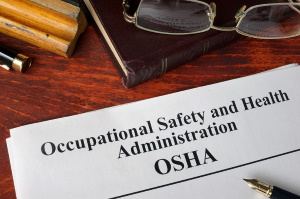Each equipment model is made using heavy die cast with working components, realistic exterior and interior detailing. Available for CAT, Toyota, JLG, and Bobcat brands.
Also available, our CASTLE Multifunction Model to help demonstrate capacity, stability and leverage to your operators. These die cast training aids are a terrific visual for every trainer to use as a training aid in their operator class.
You've Received an OSHA Citation - Now What? The 4-Step Process Every Company Should Know.

The Occupational Safety and Health Administration (OSHA) usually conducts around 32,000 inspections a year. For companies who are involved in an inspection and receive fines/citations, most are surprised by the hazards discovered and unsure of next steps to take. While avenues exist to contest findings, lower penalties, and delete citations, there are very specific steps to take and deadlines to hit in order for these options to remain available.
Are you prepared to respond to an OSHA citation?
Responding to an OSHA citation appropriately requires knowledge, manpower, and decisiveness. Follow the 4-step process below to ensure you remain compliant, protect your business, and minimize costs and fines.
STEP 1 | Correct the Hazard
Create an action plan and take steps to correct hazards as quickly and thoroughly as possible. Be sure to document every step you take (including emails, training records, relevant purchases, policy updates, etc.) so they may be presented later on as evidence of safety efforts. Appropriately correcting hazards within 24 hours may help your company to qualify for OSHA’s “quick fix” 15% reduction of penalties during the informal conference process.
If your company does not have a safety manager, consider reaching out to a safety expert who can guide you on how to quickly correct hazards as per the OSHA standard. These experts will have templates, training material, vendor recommendations, and techniques that will ultimately save you time and money.
STEP 2 | Post the Citation
Post the citation (or a copy of it) near the place where the violation occurred as directed by OSHA. The goal of this step is to ensure employees are aware of the hazard they may be exposed to. The violation must stay posted for three working days OR until the violation is abated, which ever is longer. Even if you choose to contest the violation, you must post it. Failure to post the citation can result in fines up to $13,653 per violation.
STEP 3 | Request an Informal Conference
As quickly as possible (and at least within 15 working days of receiving a citation), request an informal conference to review the hazards discovered. While this step isn’t mandatory, it is highly recommended. Benefits of an informal conference may include penalty reduction, extension of abatement dates, deletion of citations, and more. Willful violations (which have penalties as high as $136,532) are 10x more expensive than Serious violations; getting a citation reclassified can save your company considerably.
Additional ways to fight for penalty reductions include citing a good safety record, requesting an adjustment based upon the size of your company, proving a “good-faith” effort towards safe work practices, and more. Consider requesting help from a lawyer or safety expert during this negotiation process if you are unsure of how to present your best case.
STEP 4 | Decide: Agree or Contest?
If you agree to the citation, pay the proposed penalty and correct the condition by the date mandated in your citation. You must submit an Abatement Certification letter to the OSHA officer to document this hazard correction. If it is later discovered that you did not abate the hazard appropriately, you may receive an additional failure-to-abate violation (which comes with fines up to $13,653 per day).
If you disagree with the citation, you must contest it in writing to OSHA within 15 working days from the day you receive the citation (this letter is called a “Notice of Intent to Contest”). If you do not contest within this window, your citation will become a final order not subject to review by any court or agency. Once properly filed, the Notice of Intent to Contest suspends your legal obligation to pay penalties and make abatement efforts until the item contested has been resolved.
When faced with an OSHA citation, it is important that employers understand their rights and responsibilities. It is vital to act quickly, take steps to correct the hazard immediately, move forward decisively, and process paperwork in a timely manner during the 15-day working window after a citation is received. Missteps during this timeframe often result in higher fines and additional citations.
Ask Bob

Free technical support for all IVES Certified Trainers!
Question:
Hi Bob! We are updating our certification process to re-certify our operators every two years instead of the three required by regulations. Is there a standard of how long old records for current employees must be kept before purging them? Also, is there a standard of how long old records must be kept for former employees before purging them? Thanks so much!
Answer:
Thanks for checking in with us.
Record retention:
1. Current employees: you would keep everything, nothing gets purged.
2. Non-employees: once they leave your employment, you are not required to keep anything at that point. Their next employer will be responsible for training. However, in my opinion, I would suggest keeping electronic copies of their training records and only purge out paper documents for at least a few years after they leave. “You just never know……….” is how I look at it.
Interesting Articles
- Excavator topples, operator suffers minor injuries...more.
- The hazards of aerial lift work...more.
- VIDEO: 16-year-old girl gets hits by front end loader while crossing the street...more.
- Which scissor lift is best suited for your job needs?...more.
- Man driving stolen front end loader goes on rampage...more.
- Boise fire rescue team saves man from excavator that fell into a 25-foot deep trench...more.